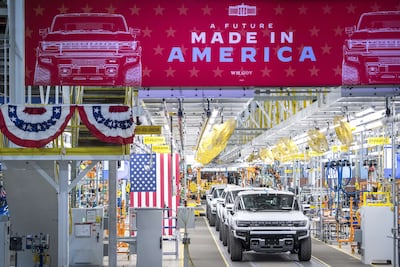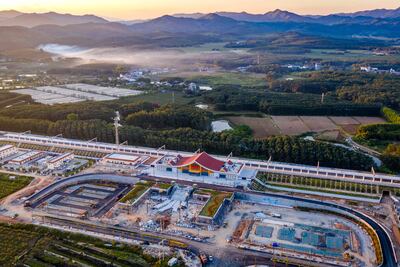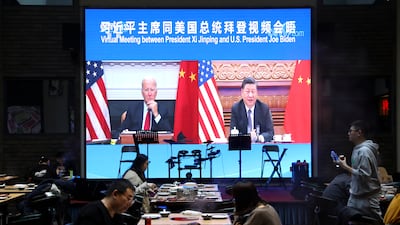During his year-ender visit to South-East Asia last month, the US Secretary of State Antony Blinken declared: “At President [Joe] Biden’s direction, we are developing a comprehensive Indo-Pacific Economic Framework that will pursue our shared objectives.”
There was clearly a sense of urgency in the US diplomat’s speech, notwithstanding the success of the Biden administration’s Asia policy in the past year. But the Biden administration now faces the ultimate challenge: providing an alternative to China’s economic influence in Asia.
If anything, the newly launched Regional Comprehensive Economic Partnership, which covers 15 Indo-Pacific economies to the exclusion of US, is expected to further accentuate China’s economic dominance. Nevertheless, the Asian power’s slowing growth rates and declining reliance on exports also need to be considered.
It is doubtful that the US will ever regain its historical dominance in Asia, especially its status in the period after the Cold War. Thanks to its lacklustre trade-industrial policy, it has struggled to match China’s economic initiatives in Asia. But the Biden administration can and should enhance America’s economic footprint if it seeks to maintain a significant presence there.

The convergence of three elements has undermined America’s ability to project economic power in the region. First, decades of neoliberal reforms have hollowed out America's manufacturing base. Once-thriving industrial cities in the Midwest have turned into rustbelts of despair.
Since the mid-1990s, countless factories from America have been outsourced and relocated to emerging markets in Asia and Latin America. Thus, within a single generation, the US was transformed from the world’s largest industrial power and creditor into the biggest (and among the most indebted) consumer markets. In the 1960s, its Gross Domestic Product was equivalent to 40 per cent of total global economic output. Half a century later, the number stood at only 22 per cent.
And this brings us to the second factor, namely the rise of trade protectionism – essentially the adoption of defensive policies that restrict international trade to help and protect domestic industries – in sectors that affected large sections of the American working class that bemoaned wage stagnation and rising inequality.

The 2007-08 global financial crisis triggered a wave of populist nationalism, which upended American democracy. The result was the 2016 election of Donald Trump, America’s first right-wing populist in a generation, who won on a protectionist “America First” agenda.
Mr Trump nixed his predecessor Barack Obama’s signature foreign policy initiatives, most notably the Transpacific Partnership Agreement that was supposed to help US reinforce its flagging influence in Asia. Overseas, Mr Trump emphasised the need to revive manufacturing at home.
But while the US succumbed to protectionist impulses, a resurgent China rapidly became the factory of the world. In East Asia, for instance, China’s share of regional GDP ballooned from 8 per cent in 1990 to 51 per cent in 2014.
The third reason why America can’t compete as effectively against China is that unlike the Asian superpower, the US government has a limited ability to corral major domestic corporations for strategic investment overseas. In contrast, Beijing can mobilise the country’s national champions for international projects, especially for the Belt and Road Initiative.

Upon assuming power, the Biden administration promised to restore America’s global leadership by taking on a rising China. Amid a raging pandemic last year, top officials held meetings with their Asian counterparts. Within a span of weeks, Defence Secretary Lloyd Austin and Vice President Kamala Harris visited multiple South-East Asian countries, and after four years, an American president attended the US-Asean Summit.
But the Biden administration went beyond embracing the maxim that 80 per cent of diplomacy is simply showing up at crucial meetings. Thanks to its extensive "vaccine diplomacy", which saw South-East Asia receive more than 23 million vaccine doses, Washington regained significant goodwill in the region.
Even the Beijing-friendly Philippine President Rodrigo Duterte fully restored the crucial Visiting Forces Agreement, which facilitates US military drills in the South-East Asian country, in gratitude for large vaccine donations.
The Biden administration also institutionalised strategic and defence co-operation with Japan and Australia, as well as India under the aegis of the Quad. The grouping's objective is to establish an "integrated deterrence" strategy, whereby US and key allies can check China’s assertiveness across the Indo-Pacific.
Nevertheless, US officials have recognised that the Indo-Pacific region, which accounts for 60 per cent of global GDP and more than half of the world’s population, is of immense economic significance. To maximise America's strategic footprint, the Biden administration has moved on three fronts.
First, it has launched a “Made in America” initiative to revive domestic manufacturing. Second, it has launched infrastructure initiatives with likeminded entities – Japan, Australia and Europe – to invest in South-East Asia. And lastly, it is pushing for a Digital Free Trade deal to enhance economic links with more advanced economies in the Indo-Pacific.
Although dominant, China’s centrality to regional trade may actually have peaked. Over the past two decades, trade as a share of China’s GDP fell from 35 per cent to less than 20 per cent in recent years. This trend is expected to continue as China’s economy slows and becomes more reliant on domestic consumers.
In turn, the Biden administration can make strides by finalising a digital free trade pact, which could lead to more consequential trade and investment agreements across key Asian economies. Overall, the Asian economic landscape is rapidly evolving beyond traditional trade – which is China’s forte – thereby providing opportunities for powers such as America to reassert influence.


